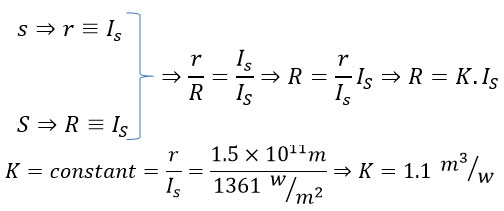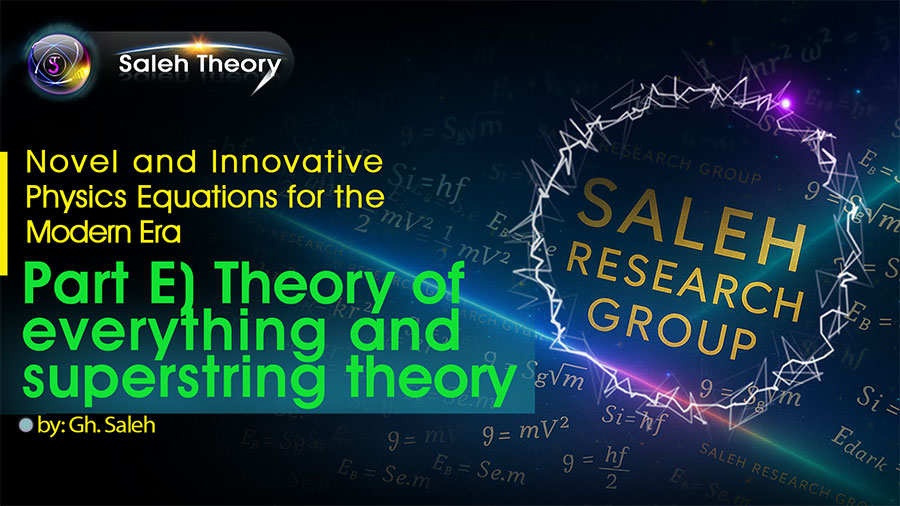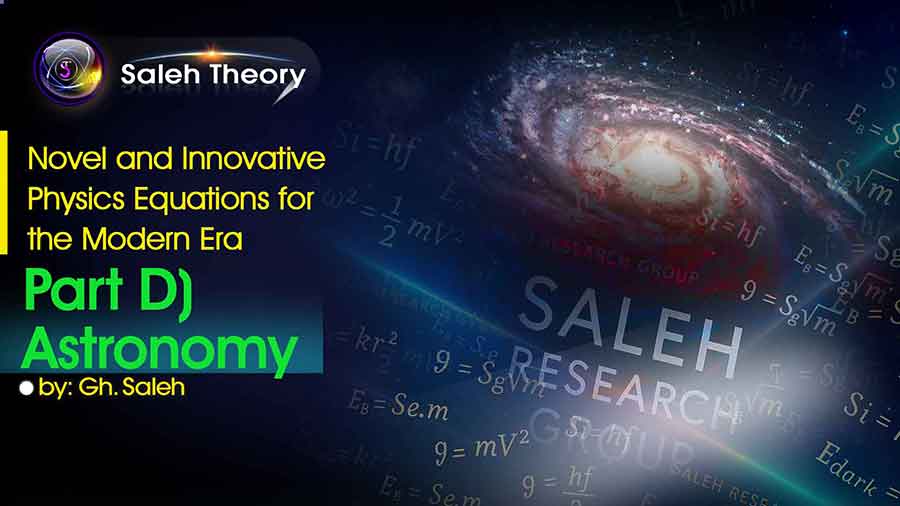
Novel and Innovative Physics Equations for the Modern Era
Part D) Astronomy
Astrophysics and Astronomy are advanced branches of the natural sciences that focus on studying the universe on a large scale. Astrophysics applies the laws of physics to analyse phenomena such as dark matter, dark energy, and the equations of motion and energy of celestial bodies. In this field, fundamental concepts such as the angular velocity of galaxies and the behaviour of matter under the extreme conditions of the early universe, including the energy at the moment of the Big Bang, are investigated.
Astronomy, on the other hand, emphasises the observation and spatial positioning of celestial objects, employing tools such as astronomical geographic coordinates to enable more precise analysis of the sky. Another important area of study is the Habitable Zone in different planetary systems — regions where the presence of liquid water, and therefore the potential for life, is most likely. These topics form the foundation for our understanding of the structure, origin, and future of the cosmos. In the following sections, we will explore in more detail the topics studied by Saleh Theory:
1. Energy at the moment of the Big Bang
Up to now, scientists have used E=mc2 to calculate the total energy at the Big Bang moment. They have estimated the total mass of our observable universe (about 1053 kg) and by using the E = mc2, have calculated the total energy:

This energy is the total energy of the Big Bang if we suppose that the biggest part of this total energy is converted to mass, and a very small remained part is converted to the kinetic energy of this created mass.
But according to the Big Bang Theory, at the moment of the Big Bang, our universe was a very compressed, hot and tiny globe. And in the first three minutes after the Big Bang, the mass and energy were so interconnected and compressed that no separate mass and energy could be conceived. So, it seems that the energy of such a hot and compacted globe had compaction energy too. That was not taken into account. Therefore, we must obtain the initial energy of the Big Bang with a different method.
We have used the Monte Carlo Technique to calculate the energy of the Big Bang and have supposed that the whole mass of the universe is neutrons and the atom has not yet formed. That is about 10-6 seconds after the Big Bang. By using simple calculations with appropriate approximation, we could find the energy of the Big Bang, which consists of the compaction energy too.
Suppose that our universe was a dense globe with a radius of r=100 km which was made of neutrons. So, we have calculated the total energy near the big bang moment, when the universe was a sphere with a radius of 100 km and that made only of neutrons. Based on the Monte Carlo Technique, the energy of one neutron in a neutron star with density ρ is:

Where ρ is universe density, ρ0 is a neutron density, a,b, α and β are constant. And the total energy of a neutron star, which consists of n neutrons, is:

mu and mn are the mass amounts of the universe and one neutron. So:

The total energy at the Big Bang moment, based on this method, is about 10110 J.
2. Calculating the Angular velocity using Hubble’s law
Based on the structure of the Universe it can be written the velocity equation of the Universe and its components as follows:
Total velocity of each celestial object = Rotational velocity + Linear velocity

Considering the structure of Prof. Hubble's formula, it can be concluded that the galaxies that move in the direction of a similar ω (same direction) have zero relative linear velocity.

It means that the velocity of all galaxies in the same radiant increases or decreases simultaneously. So, for all the galaxies you see in the figure, we have:

If we compare these two formulae, we can find that both are the same. H is constant and has the physical dimension of one over time. But time could not be constant. Therefore, H must be the angular velocity. On the other hand, D and r both have the physical dimension of length.
In fact, it can be said that Hubble's law shows the algebraic value of the rotational velocity of celestial objects in the Universe. And angular velocity (ω) of our universe is the same as the Hubble constant (H):

Therefore, it means the Hubble law indicates that we have rotational motion in our universe.
3&4. Linear and rotational motion equations of celestial objects & Energy equations of celestial objects
Given that the universe around us has a starting point called the Big Bang, and this starting point had an initial energy, and that due to the energy of this enormous explosion, objects in the surrounding universe expand, it can be said that our total energy is the same as the initial energy at the time of the Big Bang. On the other hand, in previous articles, we have proved that celestial objects have two types of motion: linear and rotational. Therefore, this total energy at any moment is equal to the sum of the two parts: linear energy and rotational energy.
Total Energy at the moment of the Big Bang (ET) = the Rotational Energy (Er) + the linear Energy (El)
ET = Er + El = constant
But as mentioned in previous articles, the primary motion in the universe is rotational. Furthermore, we have demonstrated that Hubble's law provides evidence for the existence of rotational motion in the universe. The speed described in Hubble's law is tangential speed, which depends on two factors: the distance from the centre, "D = r" and the Hubble constant, "H = ω" which represents the constant angular speed.
However, our universe also originates from a massive explosion, the Big Bang. This explosion generates linear motion. Therefore, to determine the physical parameters of the universe at different times, it is essential to consider both the rotational motion with constant angular velocity and the linear motion simultaneously. On the other hand, in the previous part, using the Monte Carlo method, we have calculated the total energy of the universe (ET) at the moment of the Big Bang, which was approximately 10110 joules. By applying the principle of energy conservation, we calculate various parameters from the initial moments of the Big Bang, through the end of the cosmic inflationary stage, to the present time, the time of equality between linear and rotational energy.
ET = Er + El
Here, Er represents rotational energy, and El represents linear energy. By utilising the definitions of linear and rotational energy, these two parameters are expressed in terms of the total mass of the universe, m = 1053 kg; the radius of rotation, r; the angular velocity (which is constant and equivalent to the Hubble constant ω = H = 2.27 × 10-18 s-1); and the linear speed "vl":

In previous articles, we have demonstrated that the universe was spherical at the time of the Big Bang, with a size somewhere between the Earth and the Moon r0 ≈ 105 m. Given the radius of the universe at the moment of the Big Bang, the contribution of rotational energy was negligible and could be ignored. Therefore, at the time of the Big Bang, the total energy can be considered to arise entirely from linear motion:

In the previous article, using the density of the universe, we calculated the radius of the universe (r1) at the end of the inflationary phase. Thus, we have:

As indicated—and as discussed in previous articles—over time, the amount of linear energy decreases, and an equivalent amount is added to the rotational energy. This implies that at the end of the universe’s outward trajectory, when it reaches its maximum radius, all the energy will be converted into rotational energy, and the linear energy will reduce to zero:

This represents the average deceleration that reduces the linear velocity (and consequently the linear energy). Thus, in linear motion, we observe a motion with constant negative acceleration.

Next, we examine the time when the rotational and linear energies are equal:
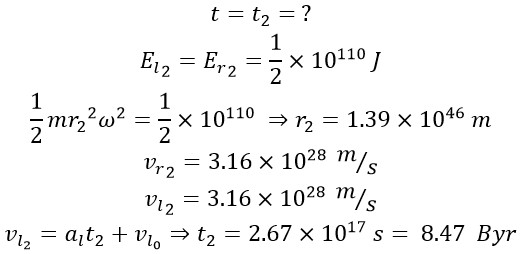
We now proceed to analyse the physical parameters of the universe at present.
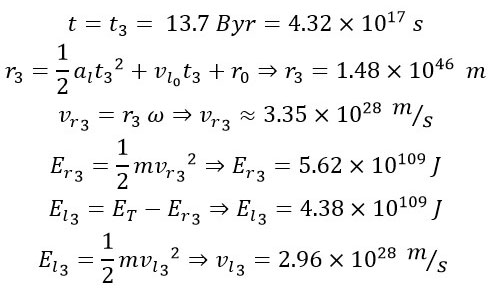
5. Dark energy
Undoubtedly, one of the most critical phenomena in the universe is the Big Bang. For countless years, humankind has endeavored to unravel its mysteries, seeking to elucidate its genesis and its ultimate fate.
At the start of the Big Bang, an extraordinarily vast amount of energy was released, propelling matter along straight trajectories as the universe expanded. Interestingly, observational data and theoretical calculations indicate that a substantial amount of energy remains unaccounted for in directly observable forms, leading to the conceptualisation of what we call "missing energy" or, more commonly, "dark energy."
Furthermore, it is a ubiquitous characteristic of celestial objects to exhibit rotational motion, as has been proven before. Consider, for instance, the Moon's rotation around its axis and its orbit around the Earth, the Earth's axial spin and its orbital path around the Sun, the Sun's axial rotation and its orbit around the supermassive black hole at the centre of the Milky Way, and so forth. Therefore, rotational motion seems to be an intrinsic property of components in the universe.
However, following the fundamental principle of the conservation of mass-energy, the aggregate quantity of mass and energy within a closed system remains invariant over time. Consequently, if we consider the overall motion of celestial objects, the resultant motion is the vector sum of both their linear (translational) and rotational components.
Typically, our analyses tend to focus predominantly on linear motion, often neglecting or failing to quantify the contribution of rotational motion. In essence, the rotational energy of the universe is the same energy that is missing. In fact, the sum of linear and rotational motion expresses the overall motion, or in other words, the sum of linear and rotational energy represents the total energy that is always constant.
Based on this framework, we can assert that the principle of mass-energy conservation remains universally valid. This combination of linear and rotational motion predicts a cyclic and repetitive motion for the motion of the universe, and we can express the comprehensive equations of motion and energy. Drawing upon the preceding discussion, we can delineate the following relations according to the principle of energy conservation:
Total Energy = Linear Energy + Rotational Energy

On the other hand, according to the Monte Carlo technique we have calculated the total energy at the Big Bang moment:

We have two types of motion: one is linear with constant acceleration a, and the other is rotational with a constant angular velocity ω, which is equal to the Hubble constant H:

The rotational kinetic energy, a form of energy often overlooked in observations, is therefore equivalent to dark energy.
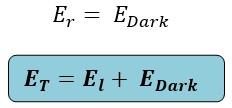
6. Dark matter
The Big Bang is a natural phenomenon in which, due to the collision of masses and particles and their subsequent explosion, an extremely large cloud comes into existence far from the central point. This immense cloud forms nebulae, which serve as the birthplace for future stars.
However, it is important to note that when cosmic inflation ends, particles begin to cluster together under the influence of magnetic forces and other gravitational forces. These clusters eventually form larger objects, such as moons, planets, stars, and so on.
It is notable that during the early inflationary period, when everything existed as gas and tiny particles, each particle in the universe's space was suspended, as gravitational effects from any specific point did not act upon it. In other words, inflation involved both linear and rotational movement, but no central force acted on these particles. Each particle remained suspended in infinite space, gradually combining with other suspended particles to form larger celestial objects.
In systems like galaxies that possess a central black hole, the black hole exerts a gravitational effect on the particles suspended in infinite space, which are not influenced by any external forces. In such systems, the central black hole can, with minimal force, hold the suspended particles-such as stars, planets, moons, and others-in orbit around itself.
So, if we consider the particles existing in the universe during the inflationary period, these are the same objects that later form stars or moons. In fact, it can be stated that dark matter is the result of particles being suspended in the infinite space during the inflationary period.
7. Virtual waves and the ranges of redshift and blueshift
According to Hubble's law (𝑉 =𝐻𝐷), if the speed of light sources, which are actually the same galaxies, is 0.2 to 0.3 of the speed of light, we have the Redshift and Blueshift phenomena, but if the speed is higher than 0.3 of the speed of light, we will have "high shift" and "low shift".
We have already calculated that at a distance of approximately 1025 meters up to 1026 meters, the phenomenon of Redshift and Blueshift is in the range of visible light. But if the distance is more than 1026 meters, it can be said that in that area, invisible objects become visible and visible objects become invisible and "high shift” and "low shift” will begin. Like the mirage phenomenon on Earth, this is an actual phenomenon. The observer's eye perceives it correctly, but it is not real.
8. Geographical Map of Galaxies and Universe
One of the most beautiful galaxies in the universe is our Milky Way galaxy, which is an almost spiral and flat galaxy that has a centre and rings that revolve around it. There is a black hole in its centre, which we call the central point “O”. We draw an imaginary line from the “O” point toward our Sun and extend it to the edge of the galaxy. We consider this imaginary line “OM” as the reference line and call it “ω0” line or “ω0” plane, which can actually be said it be the starting point to divide the plane of the galaxy into different “ω” planes.
It can be easily seen that the relevant plane can be divided into the following units: (400 gradians, 60 minutes, 60 seconds). If we multiply these 3 units together, we achieve a significant number (1,440,000), which actually tells us that we have divided the Milky Way galaxy into 1,440,000 different “ω” planes.
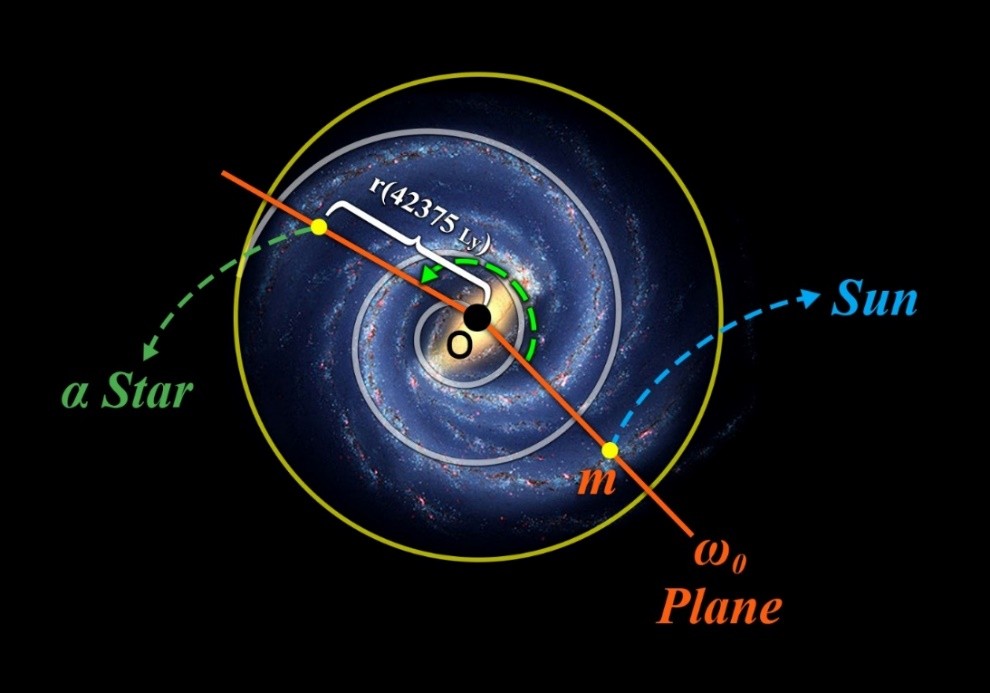
If we assume the number of stars of the Milky Way galaxy to be 100 billion and divide them by related number (1,440,000), we can obtain the average number of stars that exist in each “ω” plane, which is about 70,000. In fact, it can be said that about 70,000 stars are located in each line or plane.
Considering that the distance from the center of the galaxy to its edge is about 52,000 light-years. It can be said that for every one light-year, 1 or 2 stars can be found on this plane or line. If we want to give an identification location code to “α” star, we only need to consider its distance from the center of the galaxy and its angle address. So with these descriptions and according to the figure, we can say that the code of a star can be written as follows:

Where the “r” is the distance of the star “α” from the center and the “A”, “B” and “C” are the angle in gradian, minute and second. According to the contents, for example, the code of star “α” can be written as below:

Where the upper line is the angle and the lower line is the distance. Considering that there are approximately 70,000 stars in each omega line or plane, and compared to the 52,000 light-years radial distance, it can be said that there are no more than 2 stars in each light-year distance.
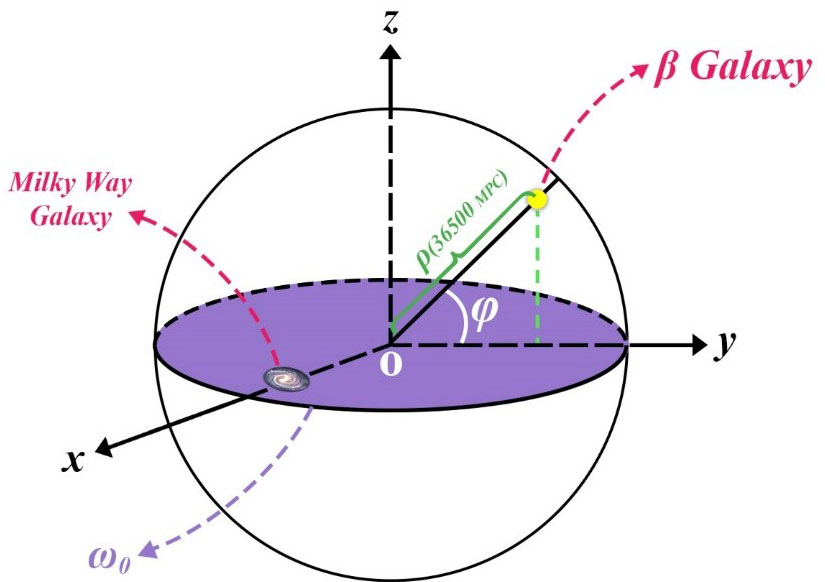
Geographical map of the universe or the set of galaxies:
In order to show the geographical map of the universe and the related codes, it is enough to consider what was obtained for the Milky Way galaxy for a plane of the globe of the universe and add an angle to it to show different planes. In this model, the origin is the centre of the universe or the point of the Big Bang, and the plane “ω0” is the plane crossing the OM line in the Milky Way galaxy and the origin. The rest of the calculations are the same as the calculations inside the galaxies.
Note: The direction of movement does not matter whether we take the “ω” planes clockwise or anti-clockwise, and it is contractual.
So, it is enough to add an angle based on radians to the previous or mentioned specifications, where “ρ” is the distance of the galaxy to the centre of the universe, and the radian angle demonstrates the location of that particular galaxy on the perimeter of a circle with “ρ” radius. For example, we consider a galaxy in the universe at point “β”:

Where “ρ” is the distance of the galaxy from the centre of the universe in megaparsec and "φ" is the angle in radians that demonstrates the particular plane where the galaxy is located. The “ρ” is between 0 and 1024 megaparsecs and the "φ" is between 0 and 2π

For example:

9. The Habitable Zone
Considering the habitable zone of our own solar system, which is the zone that can have a planet with the possibility of intelligent life with different characteristics, it is possible to calculate the habitable zone for other stars. The distance from the centre of this zone in the solar system can be considered as the distance from the sun to the Earth, and the width of the zone can be considered to be about 10% of the distance.
To get the distance of the centre of the habitable zone near other stars, it is enough to establish the following ratio and calculate the distance to the specific star:
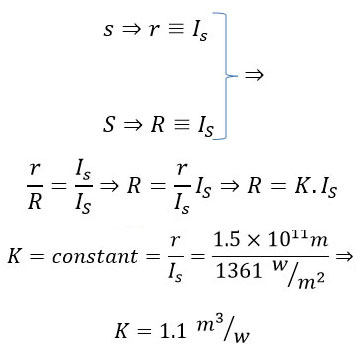
where r is the distance from the centre of the habitable zone of our solar system to the sun (the average distance of the Earth from the sun), R is the distance from the centre of the habitable zone to a certain star, Is is the intensity of the sun on the Earth and IS is the intensity of a certain star at a distance R from it.
References:
[1] Gandolfi, Stefano, J. Carlson, and S. Reddy. “Maximum Mass and Radius of Neutron Stars, and the Nuclear Symmetry Energy.” Physical Review C, vol. 85, no. 3, 2012, p. 032801.
[2] Saleh, Gh. "New Computational Table of Physical Parameters for the Moments of Beginning, Inflation, Present, and End of the Universe 2025." Saleh Theory, 29 Jan. 2025, https://saleh-theory.com/article/new-computational-table-of-physical-parameters-for-the-moments-of-beginning-inflation-present-and-end-of-the-universe-2025
[3] Saleh, Gh. "Proof of the Nature and Equations of Dark Energy Based on the Principle of Conservation of Mass-Energy in the Universe 2025." Saleh Theory, 12 Apr. 2025, https://saleh-theory.com/article/proof-of-the-nature-and-equations-of-dark-energy-based-on-the-principle-of-conservation-of-mass-energy-in-the-universe-2025
[4] Saleh, Gh. "Calculation of Energy Conservation Equations Utilizing Linear and Rotational Energy in the Universe." Saleh Theory, 14 Jun. 2025, https://saleh-theory.com/article/calculation-of-energy-conservation-equations-utilizing-linear-and-rotational-energy-in-the-universe
[5] Saleh, Gh. "Calculating the Angular Velocity of the Universe and the Photon, and the Tangential Velocity of the Universe and the Photon Part B." Saleh Theory, 18 May. 2025, https://saleh-theory.com/article/calculating-the-angular-velocity-of-the-universe-and-the-photon-and-the-tangential-velocity-of-the-universe-and-the-photon-part-b
[6] Saleh, Gh. "New Discoveries Using the Density of Galaxies in Universe 2025 (Elya Phenomenon)." Saleh Theory, 20 Jan. 2025, https://www.saleh-theory.com/article/new-discoveries-using-the-density-of-galaxies-in-universe-2025-elya-phenomenon
[7] Saleh, Gh. "Demonstration of the Rotational Motion of the Universe Using the Rotational Motion of the Planets and Stars (The Principle of Rotational Motion of Celestial Objects in the Universe)." Saleh Theory, 19 Apr. 2025, https://www.saleh-theory.com/article/demonstration-of-the-rotational-motion-of-the-universe-using-the-rotational-motion-of-the-planets-and-stars-the-principle-of-rotational-motion-of-celestial-objects-in-the-universe
[8] Saleh, Gh. "Interesting and Remarkable Similarities from the Smallest Particles to the Largest Celestial Objects Part A." Saleh Theory, 17 May. 2025, https://www.saleh-theory.com/Article/interesting-and-remarkable-similarities-from-the-smallest-particles-to-the-largest-celestial-objects-part-a
[9] Saleh, Gh. "10 Permanent, Constant and Common Principles of Motion Among the Smallest Particles (Photons, Electrons, etc.) and the Largest Objects (Moons, Planets, Stars, Black Holes, etc.) in the Universe." Saleh Theory, 11 May. 2025, https://www.saleh-theory.com/Article/10-permanent-constant-and-common-principles-of-motion-among-the-smallest-particles-photons-electrons-etc-and-the-largest-objects-moons-planets-stars-black-holes-etc-in-the-universe
[10] Saleh, Gh. "Derivation of Equations of Dark Energy's Energy Based on Physics Relations and Hubble's Law 2025." Saleh Theory, 06 Apr. 2025, https://www.saleh-theory.com/article/derivation-of-equations-of-dark-energys-energy-based-on-physics-relations-and-hubbles-law-2025
[11] Saleh, Gh. "New Discoveries about the Source of Dark Energy, Its Nature, and More: Based on the Initial Energy of the Universe (Big Bang), Hubble's Law, and Its Governing Mathematical and Physical Equations (2025)." Saleh Theory, 10 Jan. 2025, https://www.saleh-theory.com/Article/new-discoveries-about-the-source-of-dark-energy-its-nature-and-more-based-on-the-initial-energy-of-the-universe-big-bang-hubbles-law-and-its-governing-mathematical-and-physical-equations-2025
[13] Gh. Saleh, "A New Proof of Photon Velocity (VT = 3.3 C) Utilising the Young's Double-Slit Experiment and the Motional Model of Emitted Photons from Electrons in the Universe 2025 Part C." Saleh Theory, 03 May. 2025 https://www.saleh-theory.com/article/a-new-proof-of-photon-velocity-vsubtsub-33-c-utilising-the-youngs-double-slit-experiment-and-the-motional-model-of-emitted-photons-from-electrons-in-the-universe-2025-part-c
[14] Gh. Saleh, “Discovery of the Hundred-Year-Old Lost Mathematical and Physical Relationship Between the Classical Kinetic Energy of Photons and Planck’s Everlasting Experimental Equation (Planck-Saleh Energy Equation),” Saleh Theory, 28 Jun. 2024, https://www.saleh-theory.com/article/discovery-of-the-hundred-year-old-lost-mathematical-and-physical-relationship-between-the-classical-kinetic-energy-of-photons-and-plancks-everlasting-experimental-equation-in-the-universe-planck-saleh-energy-equation
[19] Saleh, Gh. "A new calculation to obtain the radius of the habitable zone around the stars of the Universe." Saleh Theory, 14 Apr. 2023, https://saleh-theory.com/article/a-new-calculation-to-obtain-the-radius-of-the-habitable-zone-around-the-stars-of-the-universe
[22] Saleh, Gh. "New Geographical Map of Galaxies and Universe by Using Omega Lines and Planes (The Exact Address of Each Star or Galaxy in the Universe)." Saleh Theory, 07 Aug. 2022, https://saleh-theory.com/article/new-geographical-map-of-galaxies-and-universe-by-using-omega-lines-and-planes-the-exact-address-of-each-star-or-galaxy-in-the-universe
[23] Gh. Saleh, “New Calculation of the Time of the Universe from Beginning to End.” Saleh Theory, 29 Aug. 2022 https://www.saleh-theory.com/article/new-calculation-of-the-time-of-the-universe-from-beginning-to-end
[27] Gh. Saleh, “The Actual and Realistic Structure of Electron.” Saleh Theory, 08 Aug. 2017, https://www.saleh-theory.com/article/the-actual-and-realistic-structure-of-electron
 Download PDF
Download PDF 

